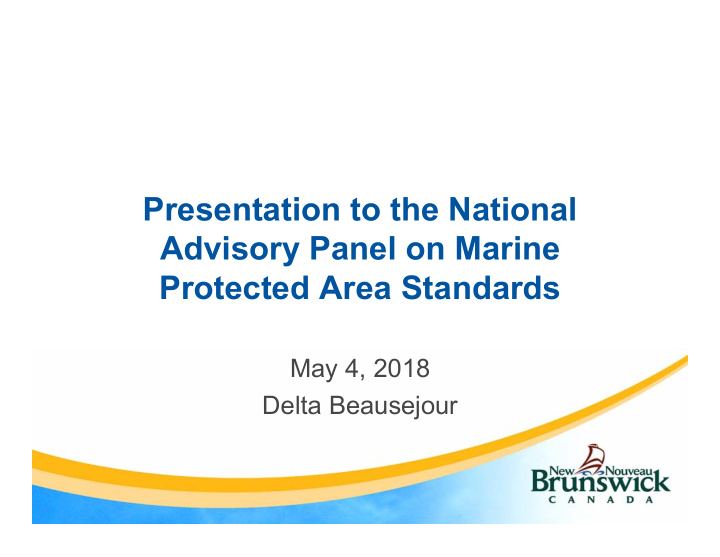



Presentation to the National Advisory Panel on Marine Protected Area Standards May 4, 2018 Delta Beausejour
NB Experience with MPAs • NB and Canada established the Musquash Estuary MPA in 2006 • NB participated in the Shediac Valley AOI review • Participation in the CCFAM Oceans Task Group • On-going discussions with DFO on MPA Network design for Scotian Shelf and Gulf of St. Lawrence regions
IUCN Categories • Provide standardization of conservation objectives into categories – for international consistency and reporting, e.g., – Protect pristine areas and conserve for reference – Protect but allow for research and education – Protect specific features – Protect ecologically important species, functions – Protect sustainable practices
What the IUCN categories are not • Not prescriptive list of activities permitted or prohibited • Not codification of activities permitted in each category • Not a hierarchy – Activities should flow from the conservation objectives for the specific MPA, not from pre-determined categories/activities – Not a prescription or proscription of activities – Would expect most Oceans Act MPAs to be in Categories 4, 5 and 6 – Other tools may be more appropriate for other conservation objective categories.
Science and conservation based standards • Standards should ensure the MPA meet their conservation objectives and not be driven by classification and reporting categories • “sites have been incorrectly assigned on the basis of activities that occur rather than using the stated management objectives” • Components for Canadian standards – Precaution (as understood by TB directives), – Ecosystem approach, – Best available science, – Costs and benefits should be known – Conservation measures should be assessed for effectiveness, benefits and costs on a regular basis – Standards should be assessed for effectiveness on a regular basis
Indigenous Approaches • Anticipate First Nations will bring forward their views on indigenous knowledge • Encourage Indigenous engagement • Existing studies (Indigenous or Traditional Use Studies) may be available to guide establishment of protection measures. • Guidelines reflecting Indigenous values, created collaboratively to demonstrate honour of the Crown and reconciliation commitment. • Input and support from local indigenous groups to manage guidelines reflecting indigenous values • Guidelines build on the balance of economic, social, environmental and Indigenous values. • Inclusion of Indigenous people in the identification of Marine Protected Areas.
MPA and other tools • The targets are for “conservation”, not MPAs. Not all the 10% has to be in an MPA • Marine conservation has many tools available: – SARA designated habitat – NMCAs – Oceans Act MPAs – Fisheries Act Marine Refuges (OEABCMs) – Fisheries Act Ecological Sensitive Areas – Fisheries Act management measures • Use the appropriate tool and coordinate the application of all tools • Marine space should have a more integrated planning process to delineate the uses: conservation, renewables, extractive, transportation and infrastructure, etc. • “A practical and functional approach to transparent management for ocean areas and activities that require co-operation of ocean users and Canadians by providing planning, risk management and clear and equitable decision making.”* *GULF OF ST. LAWRENCE INTEGRATED MANAGEMENT PLAN, DFO, 2013
Costs and Benefits • MPA standards should include consideration of costs and benefits, including equity in the costs • Benefits to “all Canadians” should not be at the exclusive “cost” to coastal communities • Conservation measures should be regularly assessed versus their conservation objectives, in both benefits and costs
New Brunswick Perspective Fish and Seafood • These sectors support thousands of New Brunswick families and is the main economic driver in our rural and coastal communities. • NB fish and seafood are internationally recognized for quality and SUSTAINABILITY. • Conservation of the marine environment and ecosystem functions is mandatory
New Brunswick Perspective – Energy • NB is a rural, coastal province and therefore our economic potential is tied to the marine environment • Energy potential in currently unknown, and unknowable until an off-shore agreement can be concluded and provide certainty for investment • Cannot conclude a cost-benefit analysis on conservation measures until energy potential is explored.
New Brunswick Perspective- Environment, Transportation and Tourism • Environment and Local Government: Existing Provincial Parks (Environmental Impact Assessments) • Transportation and Infrastructure: Operation, maintenance, upgrading and rehabilitation of existing infrastructure. • Tourism, Heritage and Culture: Growth from international markets to showcase stewardship
Thank you
Recommend
More recommend